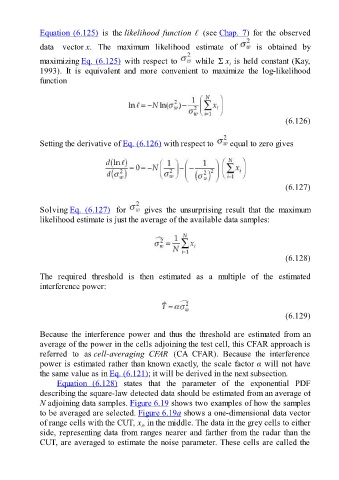Page 501 - Fundamentals of Radar Signal Processing
P. 501
Equation (6.125) is the likelihood function ℓ (see Chap. 7) for the observed
data vector x. The maximum likelihood estimate of is obtained by
maximizing Eq. (6.125) with respect to while Σ x is held constant (Kay,
i
1993). It is equivalent and more convenient to maximize the log-likelihood
function
(6.126)
Setting the derivative of Eq. (6.126) with respect to equal to zero gives
(6.127)
Solving Eq. (6.127) for gives the unsurprising result that the maximum
likelihood estimate is just the average of the available data samples:
(6.128)
The required threshold is then estimated as a multiple of the estimated
interference power:
(6.129)
Because the interference power and thus the threshold are estimated from an
average of the power in the cells adjoining the test cell, this CFAR approach is
referred to as cell-averaging CFAR (CA CFAR). Because the interference
power is estimated rather than known exactly, the scale factor α will not have
the same value as in Eq. (6.121); it will be derived in the next subsection.
Equation (6.128) states that the parameter of the exponential PDF
describing the square-law detected data should be estimated from an average of
N adjoining data samples. Figure 6.19 shows two examples of how the samples
to be averaged are selected. Figure 6.19a shows a one-dimensional data vector
of range cells with the CUT, x , in the middle. The data in the grey cells to either
i
side, representing data from ranges nearer and farther from the radar than the
CUT, are averaged to estimate the noise parameter. These cells are called the

